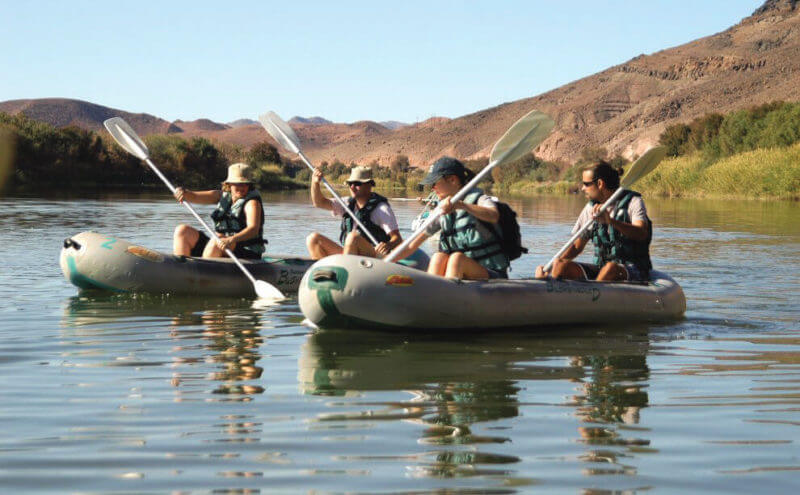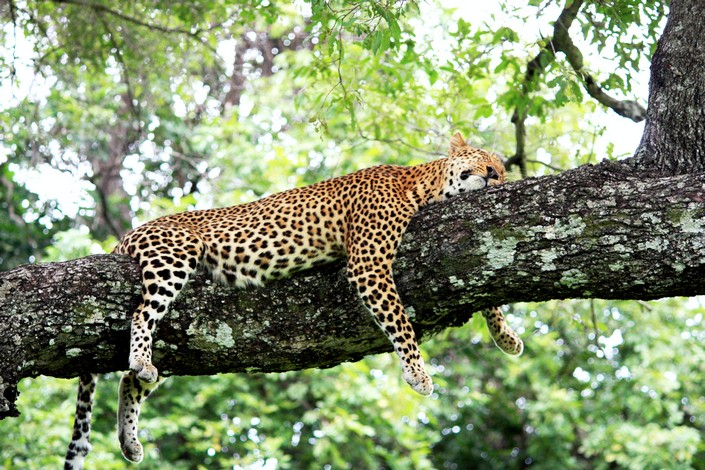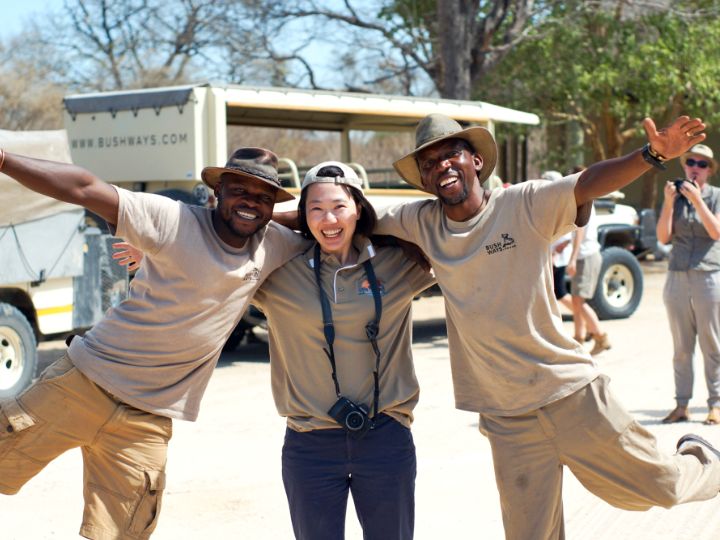The Orange River is South Africa’s longest river at 2,090 kilometres in length. Spreading over a total area of around 973,000 square kilometres, it begins in the Drakensberg mountains in the Lesotho region and runs west for around 2,200 kilometres through South Africa, emptying into the Atlantic Ocean. The river makes up part of the international borders between South Africa and Namibia, and between South Africa and Lesotho, as well as numerous provincial borders in South Africa. Aside from Upington, the River doesn’t flow through any main cities. The Orange River plays a crucial part in the South African economy by providing water for irrigation and hydroelectric power.
View Tours that Go to the Orange River
A well-known belief is that the Orange River was given its name due to the ‘orange’ hue of the water, as opposed to the Vaal River, which means ‘grey’.
Why is The Orange River is perfect for canoe trips
As the River is a collection point for most of South Africa’s water, it is vital in supporting agriculture, industry and mining. This has led to the establishment of two big water plans, including the Orange River Project and the Lesotho Highlands Water Project. Due to the lack of dangerous wildlife and high water levels in the summer months, the River is often used for thrilling activities such as canoeing and rafting.
The Orange River is not a region that is inhabited by much wildlife, with just 16 fish species living within its waters, of which seven are endemic to the River’s system. These include the common carp, Mozambique tilapia, western mosquito fish and rainbow trout. The River doesn’t house any big animals due to its location. It was once populated with many hippo, but in the 1800s the creatures were hunted to extermination.
The Gariep Dam, which is located close by to Colesberg, is the primary storage unit within the Orange River. The villages surrounding this dam as well as Vanderkloof Dam, offer fantastic accommodation with views of the countryside. In 1867, the first diamond was found in South Africa (the ‘Eureka Diamond’), nearby Hopetown on the Orange River. Two years after this, a much bigger diamond called the ‘Star of South Africa’ was discovered in the same region, thus creating a diamond rush. The rush was soon overshadowed by the diamonds of Kimberley in 1871, but alluvial diamonds continue to be found near the Orange River even today.
When to visit The Orange River
Throughout March and April, the River usually experiences good rainfall that allows canoeists to easily travel up to thirty kilometres a day. The lower areas of the River are most well-loved due to their incredible landscapes. Orange River rafting is conducted through the Richtersveld desert, which boasts unique plant and wildlife, rock formations and ideal year-round temperatures. This is one of the best adventure routes in Southern Africa.
Guides are available to lead you on various trips on the river, or hikes through the area, all the while educating you about the area’s intriguing eco-system. Known as the ‘great river’ by the local Nama folk, this River supplies an unforgettable outdoor experience to those seeking peace and adventure.
Related articles:
Places to Camp along the Orange River
10 Interesting Facts about the Orange River
- Longest River in South Africa The Orange River, also known as the Gariep River, is the longest river in South Africa, stretching approximately 2,200 kilometers (1,367 miles) in length.
- Source and Flow The river originates in the Drakensberg Mountains in Lesotho and flows westward through South Africa and Namibia before eventually emptying into the Atlantic Ocean.
- Border River The Orange River serves as a natural border between South Africa and Namibia for a significant portion of its course.
- Lifeblood of the Region The river plays a vital role in supporting the ecosystems and communities along its path. It provides water for agriculture, sustains wildlife, and offers recreational opportunities for locals and visitors alike.
- Orange River Basin The Orange River Basin is the largest river basin in South Africa, covering an extensive area that includes parts of Lesotho, South Africa, and Namibia.
- Rafting and Canoeing The Orange River is a popular destination for river rafting and canoeing enthusiasts. Its rapids and calm stretches offer different levels of difficulty, making it an exciting adventure for outdoor enthusiasts.
- Rich Biodiversity The Orange River supports a diverse range of plant and animal species. The riverbanks are home to various bird species, and fish such as yellowfish and catfish can be found in its waters.
- Diamond DepositsThe Orange River played a significant role in the diamond rush of the late 19th century. Alluvial diamond deposits were discovered along the riverbanks, leading to the establishment of diamond mining operations in the region.
- Fish River Canyon The Orange River is responsible for the formation of the Fish River Canyon, which is located in southern Namibia. It is the second-largest canyon in the world, surpassed only by the Grand Canyon in the United States.
- Hydroelectric Power The Orange River is harnessed for hydroelectric power generation. The Vanderkloof Dam, located on the river, supplies water to a hydroelectric power station that contributes to South Africa’s energy production.
Things to Do Along the Orange River
The Orange River, with its diverse landscapes and vibrant ecosystem, is a haven for a wide range of activities. Whether you’re an adrenaline junkie or a nature aficionado, this majestic river has something to offer for everyone. The array of activities available along its course caters to different interests and skill levels, ensuring that every visitor leaves with unforgettable memories.
Rafting and Kayaking
Rafting and kayaking on the Orange River presents a thrilling adventure for those seeking to add a dash of excitement to their journey. The river, known for its varying rapids, offers a delightful challenge that ranges from gentle flows ideal for beginners to more turbulent stretches that test the skills of experienced rafters. As you navigate the meandering river, you’re not just conquering rapids – you’re also immersing yourself in the stunning natural beauty that surrounds you. The experience is both exhilarating and serene, a unique combination that makes rafting and kayaking here a must-do activity. Companies along the river offer guided tours, ensuring safety and an enriching experience, whether you’re paddling through calm waters or navigating challenging rapids.
Fishing
Fishing along the Orange River is an experience that blends relaxation with the excitement of the catch. The river’s rich aquatic life includes sought-after species like the Yellowfish and Catfish, making it a popular spot for anglers. Whether you’re a seasoned fisherman or trying your hand at fishing for the first time, the river provides an ideal setting. Its banks, often lined with reeds and rocks, create the perfect environment for these species to thrive. Fishing here is more than just a sport; it’s a way to connect with nature, appreciate the stillness of the outdoors, and maybe even engage with local fishing traditions. Remember to check for any necessary permits and local guidelines to ensure a responsible and sustainable fishing experience.
Hiking and Nature Walks
For those who prefer terra firma, the landscapes surrounding the Orange River offer some of the most scenic trails in South Africa. Hiking and nature walks here are a celebration of the outdoors. Trails range from easy walks to more challenging hikes, suitable for different fitness levels. As you traverse these paths, you’re treated to breathtaking views of the river, diverse ecosystems, and possibly even wildlife sightings. The flora along these trails is as diverse as it is beautiful, with a chance to see indigenous plants and flowers unique to this region. These hikes are not just about physical activity; they’re an opportunity to slow down, breathe in the fresh air, and absorb the natural beauty of South Africa. Whether you’re looking for a leisurely walk or a challenging trek, the trails around the Orange River provide a perfect backdrop for an unforgettable outdoor adventure.
Star Gazing
But wait, there’s more! Have you ever tried star gazing? Out here, away from the city lights, the night sky over the Orange River is simply mesmerizing. Laying back on the riverbank, under a blanket of stars, is an experience that words can barely do justice. It’s these moments of tranquility and awe that really connect you with nature and maybe even with yourself.
So, you see, the Orange River isn’t just about the water – it’s a gateway to a plethora of experiences, each unique and memorable in its own right. Whether you’re paddling through rapids, reeling in a big catch, exploring trails, or just soaking in the natural beauty, this river offers something special for everyone. It’s a place where adventures are waiting around every bend, and trust me, you’ll leave with stories to tell and memories to cherish.






0 Comments